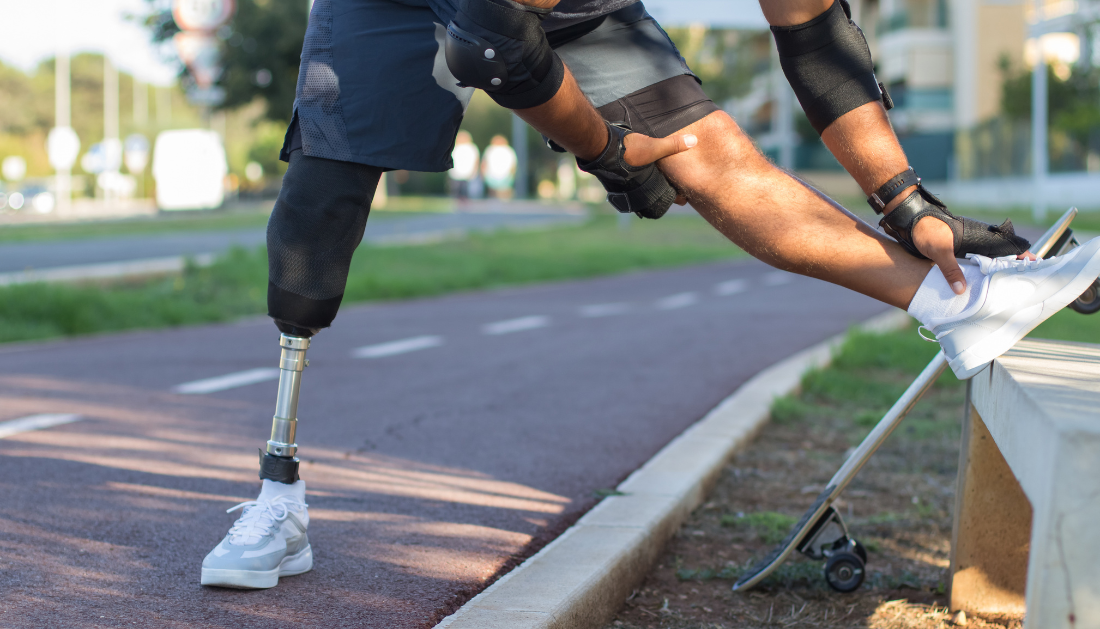

Spinal cord stimulation can elicit sensation in the missing foot and decrease phantom limb discomfort in persons with lower limb amputations, according to rehabilitation specialists at the University of Pittsburgh School of Medicine.
Pressure sensors on a prosthetic foot’s insole triggered electrical pulses, which were subsequently sent to a participant’s spinal cord. This sensory feedback improved balance and gait stability, according to the researchers. The proof-of-concept work was conducted in partnership with academics from Carnegie Mellon University and the University of Chicago, and it was published in Nature Biomedical Engineering.
“We’re using electrodes and stimulation devices that are already widely used in clinics and that physicians are familiar with implanting,” said senior author Lee Fisher, Ph.D., associate professor of physical medicine and rehabilitation at Pitt. “We are utilizing those technologies to produce meaningful improvements in function and pain reduction.” That’s exciting, and we’ve been working on it for quite some time.”
Eight out of ten Americans who have had a lower-limb amputation report persistent pain that is considered to be emanating from the missing leg or foot. This phantom limb discomfort frequently does not react to pain medications and significantly reduces quality of life. Furthermore, because even the most technically advanced prosthetics lack sensory feedback functionality, amputees continue to be vulnerable to balance deficits and falls, severely limiting their mobility.
Unlike a typical stimulation system, which works by overriding pain neurons with another sensory signal (similar to how rubbing your sore elbow helps relieve pain), Fisher’s team used existing spinal cord stimulation technology to restore sensory feedback by replacing the severed connections between sensory neurons in the missing foot and the central nervous system.
A pair of thin electrode strands implanted over the top of the spinal cord in the lower back were connected to a cell phone-sized stimulation device delivering electric pulses of varying amplitude and frequency to allow researchers to modulate the intensity of sensations in response to varying pressure on a prosthetic foot during walking. According to the study design, the leads were implanted for one to three months and then removed once the trial concluded.
Unlike prior studies, Fisher and colleagues were able to actively alter spinal cord stimulation parameters in real-time while individuals activated their prosthetic limb to stand or walk.
Participants reported an average 70% reduction in phantom limb pain, despite the lack of clinically available treatment options.
The beauty of this technology is its adaptability: the pilot trial shown that it may be used in persons with substantial peripheral nerve loss caused by chronic illnesses such as diabetes, as well as in those who have had traumatic amputations. It also does not necessitate expensive custom-made electrodes or unusual surgical procedures, making it easy to scale up on a national scale.
“We are able to produce sensations as long as the spinal cord is intact,” Fisher added. “Our approach has the potential to become an important intervention for lower-limb amputation and, with proper support from industry partners, translated into the clinic in the next five years.”
more recommended stories
 Fat-Regulating Enzyme Offers New Target for Obesity
Fat-Regulating Enzyme Offers New Target for ObesityKey Highlights (Quick Summary) Researchers identified.
 Spatial Computing Explains How Brain Organizes Cognition
Spatial Computing Explains How Brain Organizes CognitionKey Takeaways (Quick Summary) MIT researchers.
 Gestational Diabetes Risk Identified by Blood Metabolites
Gestational Diabetes Risk Identified by Blood MetabolitesKey Takeaways (Quick Summary for Clinicians).
 Phage Therapy Study Reveals RNA-Based Infection Control
Phage Therapy Study Reveals RNA-Based Infection ControlKey Takeaways (Quick Summary) Researchers uncovered.
 Pelvic Floor Disorders: Treatable Yet Often Ignored
Pelvic Floor Disorders: Treatable Yet Often IgnoredKey Takeaways (Quick Summary) Pelvic floor.
 Urine-Based microRNA Aging Clock Predicts Biological Age
Urine-Based microRNA Aging Clock Predicts Biological AgeKey Takeaways (Quick Summary) Researchers developed.
 Circadian Control of Neutrophils in Myocardial Infarction
Circadian Control of Neutrophils in Myocardial InfarctionKey Takeaways for HCPs Neutrophil activity.
 E-Cigarette Use and Heart Attack Risk in Former Smokers
E-Cigarette Use and Heart Attack Risk in Former SmokersKey Takeaways for Clinicians and Nurses.
 36-Week Pre-eclampsia Screening May Reduce Term Risk
36-Week Pre-eclampsia Screening May Reduce Term RiskA New Preventive Strategy for Term.
 Cardiovascular Risk and Sudden Cardiac Death in Diabetes
Cardiovascular Risk and Sudden Cardiac Death in DiabetesRising Sudden Cardiac Death (SCD) Risk.

Leave a Comment